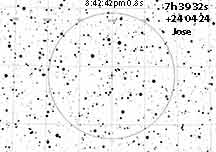
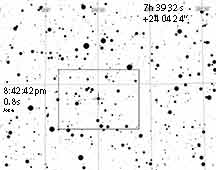
This is a bright event, but also has significant sun interference at sun= -9. My experience says it's still doable, but will require efficient 2-star align during twilight and a generous field for the Watec, which I have provided below. It's in Gemini, fortunately, with lots of bright stars to help guide us. The rank is high and we're deep inside the shadow, so it should be a good harvest of data.
Duration max predicted = 0.8s
Alt=52, Az=262 in Gemini 5 degrees below/left of Pollux.
I advise going with 1x setting, and once you've located the star, perhaps even removing the focal reducer in order to darken the sky.
The path misses you, Karl, but Olive Springs Quarry is inside the path. However, at the optimal spot at the lower quarry, you're also on top of David Oesper's track. Castelegno's would be better, and it's closed at that time tonight.
 |
 |
I observed from the foot of my driveway. Got a ~1s event with 1x setting and f/3.3 reducer. the sun = -9 was not a problem once we got within 12 minutes of the event. The target star was quite easy to see at 1x, and a star even 1 magnitude dimmer could have yielded a good detection.
I analyzed in field mode, with median filtering in horizontal and vertical.
magDrop report: percentDrop: 89.7 magDrop: 2.466 +/- 0.555 (0.95 ci)
DNR: 3.30
D time: [03:42:41.3930]
D: 0.6800 containment intervals: {+/- 0.0063} seconds
D: 0.9500 containment intervals: {+/- 0.0167} seconds
D: 0.9973 containment intervals: {+/- 0.0419} seconds
R time: [03:42:42.5448]
R: 0.6800 containment intervals: {+/- 0.0063} seconds
R: 0.9500 containment intervals: {+/- 0.0167} seconds
R: 0.9973 containment intervals: {+/- 0.0419} seconds
Duration (R - D): 1.1518 seconds
Duration: 0.6800 containment intervals: {+/- 0.0095} seconds
Duration: 0.9500 containment intervals: {+/- 0.0225} seconds
Duration: 0.9973 containment intervals: {+/- 0.0502} seconds
I note my event was clearly longer than the predicted 0.8s by almost 40%. Could this be odd shaped and I got the long dimension? There is a "half hearted" rise at the same point in the light curve that Kirk saw a rise to full brightness. Did the star just barely diffract over the edge of a valley, or binary asteroid? I'd write it off as noise except for Kirk's light curve showing a more forceful example of the same.
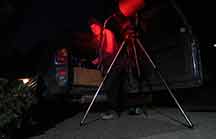 |
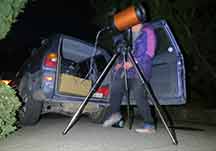 |
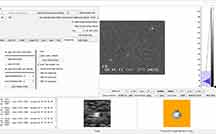 |
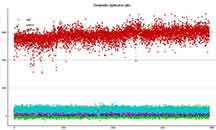 |
 |
 |
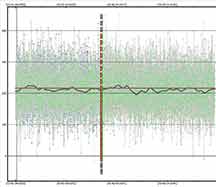 |
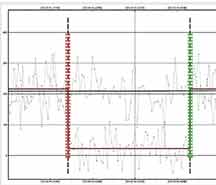 |
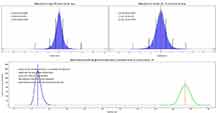 |
RN: Got a positive, at 2x with reduced gain. His timings show a 1.00s total duration, but with a spike to full brightness well inside the occultation. His comparison star looks well behaved during the event period and before/after. However, the ref star jump to higher brightness at two different moments before the event are hard to explain by wind shake. And he recalls no wind. It's hard to know what dynamic mask tracking on a shaky target would produce.
I got a 1 second positive for Jose, 2x with lower gain, from home, May 4th. It seemed too dim or noisy at 1x.
There is intermittent camera shake in the recording, but I don't recall there being wind. I must have bumped the tripod, or the chair touching the tripod, or brushing on the cables. I used dynamic apertures to keep tracking with the shake. I tried two stars for tracking, but it lost tracking at one point, probably because one of the tracking stars was too dim for the shake. So I ran pymovie again with only one tracking star, the bright one, and it tracked better, and I used the second brightest as a reference for normalization.
There is a spike in the center of the event, where it reaches full brightness for one integration. Unfortunately, some shake happened at the time of the event, but I would think that shake would smear the target and make it less bright, not more. I got nearly the same duration and D and R as you but I see your event was flat at the bottom.
Could I have got a graze? Seems like it's too bright in the middle of an event for noise. See what you think.
Here is a "square wave" solution which ignores the rise in the middle of the occultation. As such, it should not be taken as the last word...
magDrop report: percentDrop: 64.8 magDrop: 1.135 +/- 0.284 (0.95 ci)
DNR: 2.84
D time: [03:42:41.4880]
D: 0.6800 containment intervals: {+/- 0.0155} seconds
D: 0.9500 containment intervals: {+/- 0.0468} seconds
D: 0.9973 containment intervals: {+/- 0.1215} seconds
R time: [03:42:42.4890]
R: 0.6800 containment intervals: {+/- 0.0155} seconds
R: 0.9500 containment intervals: {+/- 0.0468} seconds
R: 0.9973 containment intervals: {+/- 0.1215} seconds
Duration (R - D): 1.0010 seconds
Duration: 0.6800 containment intervals: {+/- 0.0248} seconds
Duration: 0.9500 containment intervals: {+/- 0.0667} seconds
Duration: 0.9973 containment intervals: {+/- 0.1464} seconds
 |
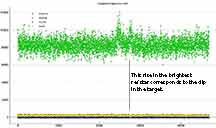 |
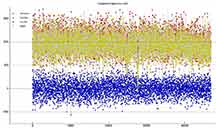 |
 |
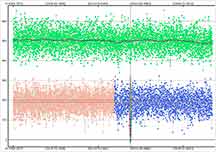 |
Trying to interpret Kirk's light curve. I notice that the brightest reg star has an excursion to rising brightness before, and right during the occultation. If that is reflected in the smoothed curve, it would add an artificial depression to the target light curve. What was the cause of those two excursions? An excursion to brighter - hard to understand. Is that also seen in the light curve w/o sky subtraction?
The prior photometry of this asteroid finds a very elongated object of about 3:1 aspect ratio, which is the most extreme elongation for any known object in the solar system except (briefly) the interstellar visitor Oumuamua. It looks like my long event went down the long axis of the meat of this asteroid, while Kirk's chord was more grazing and included a return to ~full brightness, and with Fresnel diffraction giving some light not at zero for much of his occultation "bottom". Dave Gault did a solution with fit to the photometric model and his timings. Very interesting! To confirm such a highly elongated object in "graze" fashion.
|
Dave Gault's solution for our timings. A large asteroid with an extreme shape. Clearly this object is not a rubble pile of smaller components, but is made of a rigid solid interior and at best a layer of loose regolith on the surface. |